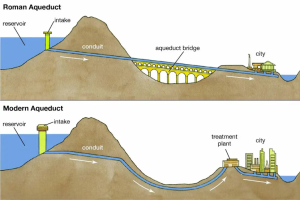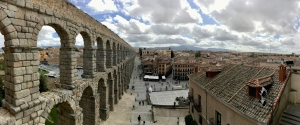WATER HISTORY WEDNESDAY | EDITION 03
Fortunately, the discoveries and advancements made through the Indus Valley River Civilisation, also appeared across the globe, with Ancient Rome representing one of the most successful innovators for water technology in this period.
In modern engineering, an aqueduct is simply defined as any system of pipes, tunnels, structures that carry water from a source to a distribution point. In ancient terms, this is commonly used to refer to the large bridge-like watercourses constructed across southern Europe and the Middle East for this same purpose, with the most famous example being the Roman Aqueducts.
Although previously existing in earlier civilisations, including Egypt and India, the Romans improved on the aqueduct structure, building structures that spanned kilometres that developed into an extensive and complex network of aqueducts across Roman territories.
The Romans were not the first to construct an aqueduct, qanat systems – a water supply system that channelled water from underground mountain water sources to dedicated places for irrigation and domestic use – were seen in Persia, India, Egypt and other Middle Eastern countries years earlier. Perhaps the next most important to note, and the most similar Roman structure of aqueduct, was the Assyrian limestone aqueduct built in Nineveh in about 691 BC. This aqueduct was 10 metres high and 275 metres long and supplied water across a valley to the city.
The Roman Aqueducts remain a major engineering achievement. These aqueducts consisted of tall stone archways extending over a valley. The arches were fitted with a stone trench that ran along the top which held and transported the water from its source to its destination in the Roman cities. The systems were built to bring water to Rome from as far away as 92 km. The aqueducts were so integral to Roman society that at the height of the empire, the Romans built aqueducts where they went, suggesting that they built them in as many as 200 cities around the empire.
How did they work?
The Romans capitalized on the use of gravity for their aqueducts to work. They constructed the aqueducts to slope downwards from lakes and springs. When contending with a valley, they would construct the sloping arched bridges that we famously recognise as the aqueducts, for water to travel along. Without an elevated rise to travel from, the aqueducts would not work. For this reason, the Romans would spend time surveying hilly areas to ensure a sufficient fall in elevation over the required distance.
These aqueducts were constructed over a number of years, with Roman slaves used to do the ditch digging, lifting and construction work. Years of surveying, land management and planning went into its creation to ensure that the water was able to travel at the right speed so as not to wear down the stone from being too fast, and to avoid the water becoming stagnant and undrinkable if too slow.
In the event of a gradient being too steep, tunnelling and pressured pipes (called inverted siphons) were required. With siphons, water travels down one side of the valley in watertight pipes with the water pressure forcing water up the other side.
Upon arrival to the city, the water was filtered into a large distribution tank known as a castellum, with smaller branch conduits running to various districts in the city that held their own smaller castellums. From there these would branch off again via pipes which would finally reach the local fountains, houses and baths.

How did the Roman Aqueducts last so long?
The success of the Roman Aqueducts can largely be attributed to their construction, both through design and the materials used.
The aqueducts moved water both above and below ground. The above-ground bridges were sometimes only 20% of the overall design with more built underground to protect against erosion and to minimise the construction in surrounding fields and neighbourhoods. The underground network of pipes was lined with clay to prevent leaks as water travelled along them from the mountains into the city.
The existence of these aqueducts today is largely due to the materials used in their construction. Roman aqueducts, unlike the limestone system in Assyria and others built in the Middle East, were constructed using a mixture of stone, brick and a volcanic cement known as pozzolana. The pozzolana is what held it all together, with this substance being a key ingredient in how the Roman aqueducts remained so strong.
The Roman aqueduct structure was so strong that they have withstood the test of time and can still be seen today in Bulgaria, Croatia, France, Germany, Greece, Israel, Lebanon, Spain, Tunisia, and other former Roman colonies. The example below depicts the Segovia aqueduct. This aqueduct is still in use today, carrying water 16km from the Frio River to the city of Segovia Spain.

Despite their strength, the aqueducts needed regular maintenance with employees directed to areas that needed repairs or upgrades. Inspection and access points were placed at regular intervals to allow the investigation of any blockages or leaks. The Romans even introduced special valves known as ‘sluice gates’ to redirect water away from damaged pipes and onto an alternative path.
The Importance of the Aqueducts in Roman Society
The aqueducts were vital to Rome in supplying a dependable water supply that was used for irrigating farming, industrial operations like mining and milling as well as public health and sanitation. They provided clean water supply for urban areas for their baths, homes and drainage systems thus promoting cleanliness and reducing waterborne illnesses within their communities.
With the fall of the Western Roman Empire, the aqueducts subsequently went into decline.
This fall can be attributed to the collapse of centralised authorities, economic decline and a decrease in population. With a lack of available human resources to complete maintenance, the aqueducts suffered deterioration which was further impacted by deliberate destruction by enemies that cut the supplies.
Despite the decline of the Roman Aqueducts, their legacy lives on and continues to be an inspiring record of Roman and human innovation. From their planning, construction and maintenance, they had a monumental impact on society and helped shape the future of water management.





